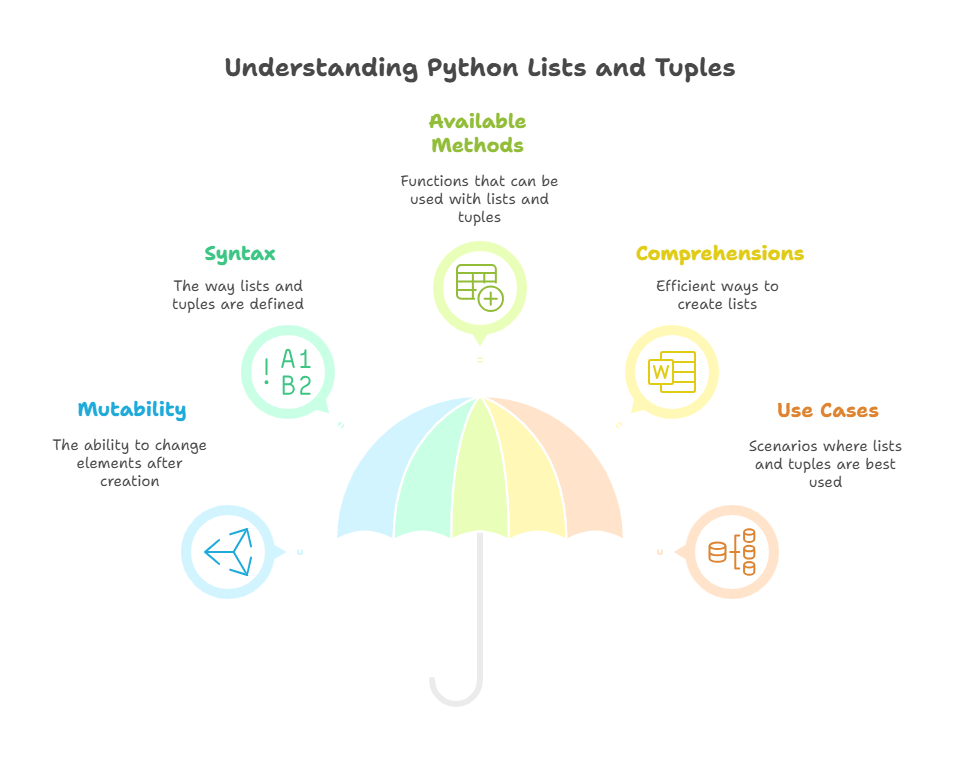
Lists and tuples are two essential built-in data structures in Python that are used to store groups of objects. Since both of these are regarded as sequence types, they preserve an ordered set of elements indexed by their integer positions, beginning with the first member at index 0. Although they have many traits and functions in common, their mutability is a crucial difference.
Lists and tuples have certain similarities.
Similarities Between Lists and Tuples:
Sequence Types: Sequences of values are what both lists and tuples are. This indicates that their elements are arranged in a particular sequence and that you can access them by their offset or position.
Heterogeneous Elements: Lists and tuples can include elements of several data types, in contrast to some other computer language array types. Any Python object may be used for each element.
Indexing and Slicing: Square brackets [] with an integer index (offset) allow you to retrieve specific elements. The slice operator [:] can also be used to extract a range of elements (a “slice”).
Iteration: A for loop makes it simple to iterate through the elements of lists and tuples.
Membership Testing: To determine whether a particular value is present in a list or tuple, utilise the in and not in operators.
Built-in Functions: Len() (which returns the amount of elements), max(), min(), and sum() are among the built-in Python functions that operate on both types. The count() and index() functions are also available in both.
Concatenation and Repetition: Two lists or two tuples can be joined with the + operator. A list or tuple’s elements can be repeated using the operator.
Example:
# Creating a list and a tuple with mixed types
my list = [10, "Python", 3.14, True]
my tuple = (20, "Code", False, 99)
# Accessing elements by index
print("List element at index 1:", my list[18])
print("Tuple element at index 0:", my tuple)
# Iterating through elements
print("Iterating through list:")
for item in my list:
print(item)
print("Iterating through tuple:")
for item in my tuple:
print(item)
# Checking for membership
print("Is 'Python' in my list?", "Python" in my list)
print("Is 50 in my tuple?", 50 in my tuple)
# Example of concatenation (External)
combined list = my list
print("Combined list:", combined list)
combined tuple = my tuple + (5, 6)
print("Combined tuple:", combined tuple)
# Example using a built-in function
print("Length of my list:", len(my list))
print("Length of my tuple:", len(my tuple))Distinctions Between Lists and Tuples:
Mutability is the major difference between lists and tuples.
Mutability:
- Lists allow for content changes after construction. Give an index or slice a new value, add items using append() or insert(), or remove them using removal(), pop(), or del.
- Tuples are immutable: Once created, their contents cannot be changed. Unchangeable elements cannot be added or removed.
Syntax: Tuples are defined with parenthesis (), although parentheses are occasionally unnecessary when forming tuples. Lists are defined with square brackets [].
Available Methods: Lists feature methods like append(), insert(), delete(), pop(), sort(), and reverse() that alter the list in-place since they are mutable. Since tuples are immutable, they lack these techniques. The only methods they have that don’t alter the tuple are count() and index().
Comprehensions: List comprehensions are supported by Python to facilitate the efficient creation of lists. Although brackets can be used with a syntax similar to comprehension, this usually results in a generator expression rather than a tuple directly. Immutable types, such as strings and tuples, must be generated in other ways; mutable kinds, such as lists, dictionaries, and sets, have comprehensions.
Example:
# List is mutable
my list
print("Original list:", my list)
my list append(4)
print("List after append:", my list)
my list = 10
print("List after changing element at index 0:", my list)
del my list
print("List after deleting element at index 1:", my list)
# Tuple is immutable
my tuple = (1, 2, 3)
print("\nOriginal tuple:", my tuple)
# Trying to change a tuple will result in a TypeError
# my tuple append(4)
# my tuple = 10
# del my tuple
print("Tuples cannot be changed after creation.")When to Use Which:
Use Lists: When you require a collection with items that may need to change over time, use lists. For ordered collections, lists are the most popular general-purpose data structure. They perform best when you often add, delete, or change objects. Lists can also model queues and stacks.
Use Tuples: When the set of things is fixed and shouldn’t change, use tuples. Tuples can occasionally be processed by the computer more quickly than lists since they are immutable. They are helpful for guaranteeing data integrity when the contents should stay consistent or for describing stable groups of linked data, like geographic coordinates (latitude, longitude). When a function must return many values, tuples are also frequently employed. By default, Python packs these values into a tuple, which can subsequently be unpacked into distinct variables. For basic data structures, named tuples can provide a straightforward substitute for class definition.
In conclusion, lists and tuples are both sequence types in Python that can handle operations like indexing, slicing, iteration, and membership testing in addition to storing heterogeneous components. The primary distinction is that tuples are immutable (unchangeable), whereas lists are mutable (changeable). The available techniques and their common programming use cases are impacted by this distinction.
